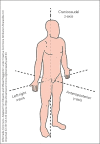Augmented-reality-guided insertion of sliding hip screw guidewire: a preclinical investigation
- PMID: 35613719
- PMCID: PMC9202824
- DOI: 10.1503/cjs.025620
Augmented-reality-guided insertion of sliding hip screw guidewire: a preclinical investigation
Erratum in
-
Correction: Augmented-reality-guided insertion of sliding hip screw guidewire: a preclinical investigation.Can J Surg. 2022 May 31;65(3):E381. doi: 10.1503/cjs.007222. Print 2022 May-Jun. Can J Surg. 2022. PMID: 35641248 Free PMC article. No abstract available.
Abstract
Background: The sliding hip screw (SHS) is frequently used in the management of hip fractures; successful placement depends on accurate positioning of the lag screw in the femoral head guided by fluoroscopy. We proposed to leverage the capabilities of augmented reality (AR) to overlay virtual images of the desired guidewire trajectory directly onto the surgical field to guide the surgeon during SHS guidewire insertion.
Methods: Using a commercially available AR headset and software, we performed preprocedural planning using computed tomography scans to identify the optimal trajectory for SHS guidewire insertion in the neck of a Sawbones femur model. The images of the scanned femurs containing the virtual guidewire trajectory were overlaid on the physical models such that the user could see a composite view of the computer-generated images and the physical environment. Two second-year orthopedic residents each inserted 15 guidewires under AR guidance and 15 guidewires under fluoroscopy.
Results: Of the 30 guidewires inserted under AR guidance, 24 (80%) were within the femoral neck, and 16 (53%) were fully enclosed within the femoral head. Nine (56%) of the 16 perforations were due to insertions that were too far along the planned trajectory. Thirteen (81%) of the successful attempts with AR had an appropriate position, compared to 25/26 (96%) with fluoroscopy. It took significantly less time to perform the procedure using fluoroscopy than AR (p < 0.05). Fluoroscopy required on average 18.7 shots.
Conclusion: Augmented reality provides an opportunity to aid in guidewire insertion in a preplanned trajectory with less radiation exposure in a sterile environment, but technical challenges remain to be solved to enable widespread adoption.
Contexte:: La vis de hanche à compression coulissante (VHCC) est souvent utilisée pour la prise en charge des fractures de la hanche; son bon positionnement dépend de l’installation précise de la vis tire-fond dans la tête fémorale sous fluoroscopie. Nous avons proposé d’utiliser les capacités de la réalité augmentée (RA) pour surimposer des images virtuelles de la trajectoire du fil-guide désirée directement sur le site opératoire dans le but de faciliter la tâche du chirurgien pendant l’insertion du filguide de la VHCC.
Méthodes:: À l’aide d’un logiciel et d’un casque de RA du commerce, nous avons préplanifié l’intervention à l’aide de clichés de tomodensitométrie (TDM) pour l’insertion optimale du fil-guide de VHCC dans le col fémoral d’un modèle de fémur Sawbones. Des clichés de TDM de fémurs montrant la trajectoire du fil guide virtuel ont été surimposés aux modèles physiques pour que l’utilisateur puisse avoir une image composite des vues générées par ordinateur et de l’environnement physique. Deux résidents de deuxième année en orthopédie ont chacun inséré 15 fils-guides à l’aide de la RA et 15 fils-guides sous fluoroscopie.
Résultats:: Des 30 fils-guides insérés à l’aide de la RA, 24 (80 %) se trouvaient dans le col fémoral et 16 (53 %) étaient entièrement à l’intérieur de la tête fémorale. Neuf (56 %) des 16 perforations étaient dues à des insertions trop profondes le long de la trajectoire planifiée. Treize (81 %) des tentatives réussies avec la RA étaient bien positionnées, contre 25/26 (96 %) avec la fluoroscopie. L’intervention sous fluoroscopie a nécessité significativement moins de temps que l’intervention sous RA (p < 0,05). La fluoroscopie a demandé en moyenne 18,7 clichés.
Conclusion:: La RA offre la possibilité de faciliter l’insertion du fil-guide quand la trajectoire est préplanifiée, tout en réduisant l’exposition aux radiations dans un environnement stérile, mais il reste des difficultés techniques à régler avant de pouvoir en généraliser l’adoption.
© 2022 CMA Impact Inc. or its licensors.
Conflict of interest statement
Competing interests: Edward Harvey reports grants or contracts from the Canadian Institutes of Health Research (CIHR), the US Department of Defense and the Natural Sciences and Engineering Research Council of Canada. He holds dozens of patents for orthopedic devices and methods outside the submitted work. He has participated on a CIHR institute advisory board, and has played a leadership role for the Orthopaedic Trauma Association. He holds stock in MY01 and NXTSENS Microsystems. He is also coeditor-in-chief of CJS; he was not involved in the review of this manuscript nor in the decision to accept it for publication. No other competing interests were declared.
Figures





References
-
- Cooper C, Campion G, Melton LJ, 3rd. Hip fractures in the elderly: a world-wide projection. Osteoporos Int 1992;2:285–9. - PubMed
-
- Gullberg B, Johnell O, Kanis JA. World-wide projections for hip fracture. Osteoporos Int 1997;7:407–13. - PubMed
-
- Chirodian N, Arch B, Parker MJ. Sliding hip screw fixation of trochanteric hip fractures: outcome of 1024 procedures. Injury 2005;36: 793–800. - PubMed
-
- Baumgaertner MR, Solberg BD. Awareness of tip–apex distance reduces failure of fixation of trochanteric fractures of the hip. J Bone Joint Surg Br 1997;79:969–71. - PubMed
MeSH terms
LinkOut - more resources
Full Text Sources
Medical
Research Materials
